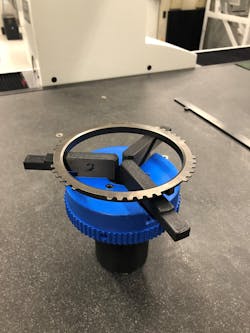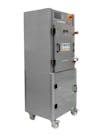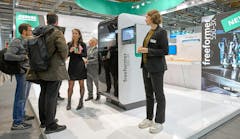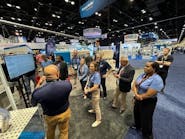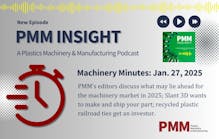Eaton Vehicle Group adopts 3-D printing to improve design, speed to market
Problem: A large manufacturer sourced parts from many different vendors, resulting in delays getting quotes on any single part.
Solution: Eaton Vehicle Group eliminated such delays and is saving money by 3-D printing some parts itself.
Additive manufacturing can transform how a company implements its manufacturing strategy. That’s the case at Eaton Vehicle Group, which provides automotive and commercial vehicle manufacturers worldwide with products and systems to improve a vehicle’s efficiency, performance and power. Its products include emission-control components; engine valves; valvetrain systems; superchargers; and transmission, clutch and torque-management products and systems.
Eaton Vehicle Group has 49 facilities on six continents, operates four regional technical centers in the U.S., Czech Republic, China and India and has approximately 15,000 employees. Its parent, Eaton, had more than $21 billion in revenue last year while selling its products in more than 175 countries.
One Eaton Vehicle Group location started working with additive manufacturing in 2013 and its popularity grew until the company standardized in 2018 on two models of polymer 3-D printers made by two companies, according to Alexandre Georgetti, director, manufacturing strategy, Eaton Vehicle Group.
“About 80 to 90 percent of our global manufacturing sites have at least one polymer printer deployed,” said Georgetti, who works at the Eaton Vehicle Group headquarters in Galesburg, Mich. “Some sites have more than one printer. By having the same two brands of 3-D printers everywhere, this allows us to share manufacturing between multiple sites. The sites can leverage each other. If one site is under a heavy workload, we can simply share the model and we are able to print the same product at a site that is less utilized. This allows us to react quickly to needs throughout our company.”
Eaton Vehicle Group is using two types of 3-D printing — fused-deposition modeling that uses ABS/polyamide and TPU resins, and Multi Jet Fusion technology that uses nylon, he said. Both can make complex parts, while the Multi Jet Fusion is used for high-demand tooling parts. The company also uses metal 3-D printers.
“We essentially follow the same strategy for both polymer and metal printing,” Georgetti said. “We started with polymer and later got involved with metal. About 70 percent of everything we are 3-D printing now is on the polymer side and 30 percent is metal. But the metal is increasing fast. Our focus is to make additive manufacturing, both polymer and metal, a standard process for Eaton worldwide.”
Additive manufacturing allows the company to design and build highly customized parts that previously were not possible due to mold costs or part geometry.
“There was a case where the device we needed to make was close to 20 inches [in] diameter, which is much bigger than what the printers can handle,” Georgetti said. “We were able to take that device and make it in multiple pieces. We printed individual pieces and combined them into a larger part.”
That transmission part, now made from plastic, was designed internally and previously had been made from metal by an external vendor, he said. 3-D printing parts that previously were made by outside vendors saves money. But speed to market is also a factor.
“Design and speed to market are the two most important advantages,” Georgetti said. “Additive manufacturing allows us to do designs that were not easy or even possible for us to do before. Equally important is speed to market. We can do things much faster than relying on external vendors. We can print things quickly, and we don’t have to wait for an external vendor. This can make a difference of hours or even days.”
He estimated that the company can cut development time by 60 percent or more using 3-D printing.
“To get a quote from a vendor, they want three to four weeks to get back to you. Now, we can do that ourselves in days,” Georgetti said. “The difference is huge.”
Savings achieved by printing parts itself can range from 40 percent to as high as 80 percent, he said.
“The range depends on how complex the part design is and how many parts we are able to combine,” he said. “Instead of having to buy several different components and put them together, we can print them ourselves.”
The company also prints fixtures and tools that it uses during manufacturing. Tooling fixtures are used to secure components during a manufacturing process. They can be simple — such as a device that holds a part on a conveyor as it feeds a machine — or more complex depending on the geometry of the part.
“We look to additive manufacturing for fixtures and tooling, quality devices and safety devices,” Georgetti said. “In one case, we needed to paint some of our products, but certain areas on the product needed to be paint-free. We leveraged the polymer additive manufacturing to develop devices to help us protect those areas, to avoid painting those areas that don’t need to be painted.”
Additive manufacturing also allows companies to be flexible and react quickly to urgent needs.
“More recently, with COVID-19, we have been leveraging this technology to support internal and external communities,” Georgetti said.
For example, the company pivoted from manufacturing some of its standard products and began 3-D printing polymer door openers that also can be used on light switches and elevator buttons to avoid touching surfaces that get a lot of hand traffic. The company also printed faceshield frames and donated them to medical facilities worldwide.
Companies that manufacture 3-D printers provide training on newly purchased machines, but users gain even more knowledge organically through trial and error.
“More learning comes from using the printers,” Georgetti said. “We create trials, develop products and share that knowledge globally so a large group of people can benefit.”
Bruce Adams, senior staff reporter
badams@plasticsmachinerymagazine.com
Contact:
Eaton Vehicle Group, Galesburg, Mich., 269-342-3000, www.eaton.com
